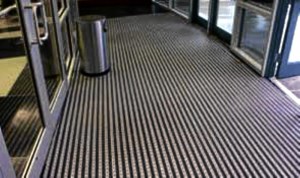
A GOOD entry flooring system helps save costs by stopping the dirt at the entrance and having to clean the dirt throughout the interiors. Photo from entrancematsonline.blogspot.com
Many building owners invest heavily on impressive entrances and lobbies by installing very expensive floor finishes to attract tenants and buyers to patronize their buildings.
Whether it’s an office building, a residential condominium or a hotel, the first impression one gets is the meticulously designed floor pattern as you enter the building, sometimes with varying shapes and colors of imported stones and tiles.
In many cases, the building management’s focus is on maintaining the overall appeal and the life of the floor finish. Many are not aware that building entrances with highly concentrated pedestrian foot traffic are the most common sources of dirt, brought into the building through pedestrians’ shoes and rainwater from their clothes.
Absorbing moisture
I have seen these even in some of the best buildings. During the rainy season, many buildings spread corrugated cardboard and area rugs in their lobbies to absorb moisture from pedestrians’ shoes and to prevent slipping accidents while janitors are busy with mopping up the rest of the lobby. Dirt that accumulates in the entrances are most likely to be carried to other parts of the building, causing more flooring maintenance costs.
Today, many green buildings consider the entrance floor maintenance system as part of their effort to provide good indoor-air quality. The reasoning behind it is quite simple: Prevent the dirt at the entrance from spreading to the other areas, thus preventing indoor pollution.
As many of us know, to avoid outdoor pollution, people seek refuge in their homes and in air-conditioned public spaces. The sad truth is, indoor pollution is said to be five times worse than outdoor pollution.
Indoor-air pollutants
Airborne fine particles and volatile chemicals accumulate to pollute the indoor environment. The culprits include dust particles, carbon emissions, volatile chemicals such as formaldehyde, which result from building materials, furnishings inside homes and offices and building systems like cleaning and equipment use.
Formaldehyde is a colorless, strong-smelling gas used to manufacture building and household products, especially as an adhesive resin in pressed wood products. New furniture and furnishings with such a smell should be allowed to outgas first, perhaps in the open lanai, before they are brought to the rooms where they are needed. Carpet shampoo, solvents, floor wax and furniture polish should be used with all windows open to allow for good air change.
Regular inspection, repair and maintenance of air-conditioning equipment, especially in healthcare rooms and facilities, seriously address health issues.
Construction activities need isolation barriers from areas occupied by people, to protect them from dust, fumes and vapors. Temporary ventilation systems if needed have to be installed in such instances.
Sequencing in construction helps maintain good indoor-air quality. It is advisable to install materials with high chemical emissions first such as painting, caulking or drying components before installing absorbent materials such as ceiling tile, carpet and office furniture.
Commercial cleaning solutions can be substituted with simple baking soda, vinegar and lemon juice for simple cleaning chores.
Eighty-five percent of the dirt entering the house or building is brought in through people’s shoes. This is why some of our Asian neighbors remove their shoes before entering their homes.
Sixty percent of total building maintenance costs go to flooring maintenance. In 10 years, building owners spend eight times the original flooring acquisition cost on floor maintenance.
Entry flooring system
Having a relatively small entrance area and installing a good entry flooring system helps save costs by stopping the dirt at the entrance and having to clean the dirt throughout the interiors.
Green designers provide a dirt and rainwater collecting system from foot traffic immediately outside the building or immediately inside the doorway. A vestibule or extended entry area follows with flooring material to address soil and water not collected at the doorway. Then the lobby or other common area uses flooring material to make sure maximum dirt and water is removed.
Singapore has the Green Mark, Australia Green Star, Great Britain the BREAM, Japan CASBEE and the United States LEED, and the Philippines also has green building rating bodies, including the Philippine Green Building Initiative or PGBI with standards that suit our climate conditions.
Almost one-fifth of the PGBI criteria for green building standards measure lighting, ventilation and views for indoor environmental quality.
For comments or inquiries, e-mail amadodejesus@gmail.com.

